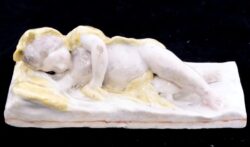It was made by the godfather of English porcelain, Nicholas Sprimont (Picture: Hansons / SWNS)
A bargain hunter stumbled upon the ‘holy grail’ of English porcelain and bought it for £2 at a car boot sale.
Now, a family member is to come into a windfall as it goes under the hammer at an auction – with an expected sale price of between £20,000-£30,000.
The six-inch white figure of a sleeping baby was purchased in Gloucestershire in the mid-1990s by a woman who had an ‘eye for English porcelain’.
She had a hunch it was something special, but kept it for nearly three decades on her shelf before taking it to an antiques expert for a valuation.
During the meeting, it was revealed that the rare sculpture was made by the godfather of English porcelain, Nicholas Sprimont, in 1745.
Experts say it marks the birth of porcelain production at London’s famous Chelsea factory, which Mr Sprimont directed. A similar example from 1746 is in the British Museum today.
The ornament has since been handed on to a relative of the woman who has decided to sell it.
Latest London news
London man reveals he’s only paying £850 a month for a ‘beautiful’ flat and people can’t believe it
Bouncer ‘called woman a “geezer bird” in vile homophobic rant’ at London pub
It will take you an average of 36 minutes to drive just 6.2 miles in London
To get the latest news from the capital, visit Metro.co.uk’s dedicated page.
Charles Hanson, owner of Hanson Holloway’s Ross, with the Chelsea baby (Picture: Hansons / SWNS)
There is a similar example is in the British Museum (Picture: Hansons / SWNS)
Auctioneer Charles Hanson has named the piece ‘extremely important because it demonstrates early attempts to make figures in the mid-18th century’.
‘A find like this is the holy grail for any keen collector of early English porcelain’, he said.
‘Many would love to acquire it. It represents the most charming and rarest of English porcelain figures.
‘It would have been inspired by the mid-18th Century passion for northern European art.’
The design may have been influenced by John Michael Rysbrack and the French factory of Vincennes produced similar examples in the early 1740s.
Mr Hanson added: ‘It is possible the Chelsea sleeping child was the result of a model sent from France.
‘The mould would have been created from a slip casting technique. On removal from the mould, touching up and undercutting of details would have been undertaken by a skilled artisan known as a repairer.
‘They would have formed a separate mould for the child’s left hand.
It will go for £20,000-£30,000, estimates say (Picture: Hansons / SWNS)
‘My early years of training focused on early English porcelain so to find an item which defines the start of its manufacture in the mid-18th century is a thrill for me.’
The Chelsea Porcelain Factory began production in 1743-45 and was the first important porcelain maker in England.
Its first known wares were ‘goat and bee’ cream jugs with seated goats at the base, but it became well-known for its figures.
The firm operated independently until 1770 when it merged with Derby porcelain.
The sleeping baby figure will be sold at Hanson Holloway’s Ross Auctions in Banbury, Oxon, on March 4.
Get in touch with our news team by emailing us at webnews@metro.co.uk.
For more stories like this, check our news page.
A bargain hunter stumbled upon the ‘holy grail’ of English porcelain.





